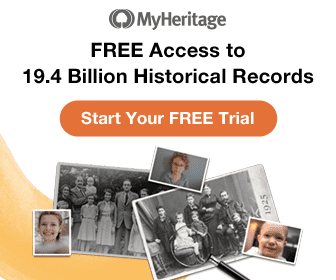If you’re looking to buy a DNA test and can’t decide between Ancestry and FamilyTreeDNA, this article is for you.
AncestryDNA
Since rolling out in 2012, AncestryDNA has collected over 15 million DNA samples to add to their database. This, of course, makes it one of the largest DNA databases in the entire world. So, if you’re looking for your biological family, this is generally the company that I encourage people to use.
Ancestry itself has over 28 billion records in its database, which, unlike its competitors, makes it accessible for its DNA users to build their trees and link together genetic networks using the documents on their site to help trace the paper trail of family members. This is the key component that sets Ancestry apart from all of the other databases.
When you view your DNA matches on 23andMe, the website does not have an interface to view your DNA matches family tree. If your DNA matches list their familial surnames on 23andMe (often a rarity), you will have to do in-depth research to create the tree yourself and put the pieces together. With Ancestry, often, if your matches have their family trees public, you can go in and find how you relate to them using the paper trails that are already compiled.
As far as genetic tools are concerned, Ancestry does not have much to offer. They do not have a chromosome browser, and they only allow you to see the amount of cM’s you share with your matches, and they display the number of shared segments.
One of the other biggest things that set AncestryDNA apart from FamilyTreeDNA is the company’s content. They allow DNA results to be populated alongside family tree data which, FamilyTreeDNA does as well but, the documents in possession of Ancestry are more vast than anywhere else. This makes it easier and faster for users to pinpoint common ancestors with their DNA match’s trees.
With that said, AncestryDNA seems like a pretty great option, right? Of course. But let us see what sets FamilyTreeDNA apart from others.
FamilyTreeDNA
Based out of Texas, FamilyTreeDNA is a large company utilized by fewer users than its competitor. Their user numbers cannot compete, but they do have tools to view data in a much more informative, if not user-friendly, way.
One tool that is accessible to FamilyTreeDNA users is their chromosome browser. This browser allows you to select yourself and up to 7 other DNA matches and run them through an algorithm that populates a visual aid of your chromosomes, chromosomes, and each chromosome segment that you and your selected matches all share. Such tools are very informative, and that alone is very hard for companies like AncestryDNA to compete with.
Furthermore, FamilyTreeDNA has a tool called “Matrix,” which allows the user to select up to 10 matches and run them through another algorithm which also provides a visual aid. This visual aid is not a chromosome browser but, instead, a grid system that allows you to see which matches share DNA with other matches. Similar to a clustering tool but on a smaller scale.
FamilyTreeDNA and AncestryDNA both offer cousin matching, and one big thing to consider is that their cM (centimorgan) thresholds are different. To have a match appear on AncestryDNA, you must share a minimum of 8cM with them. On FamilyTreeDNA, the threshold is 1cM. This means that you can have the same match on both websites, and on FamilyTreeDNA, it will appear as though you share more DNA with them, but, in reality, you don’t.
FamilyTreeDNA is known for what we call “inflated” matches because their cM threshold is low.
Another area in which these two companies differ is with their ethnicity estimates. Every company has different reference samples through which they base their user’s ethnicity estimates off of. Both, of course, are constantly updated with more granular data to better pinpoint which ethnic groups their users descend from.
FamilyTreeDNA also blows AncestryDNA out of the water because they offer specific Y-DNA tests. They also offer specific testing for MtDNA. Ancestry only does autosomal testing. FamilyTreeDNA offers Y testing, which, in itself, comes with its specific tools, including Haplogroup results which AncestryDNA does not offer. These results offer better insight into our more distant ancestry, which long precede our paper trail history.
See my complete review of FamilyTreeDNA.
Other things to consider
The many comparisons between the two companies make them seem very different; they are all used by similar people in the long run. As I said above about the cM threshold. You can have cousin matches from AncestryDNA populate into FamilyTreeDNA if they download their AncestryDNA data and upload it to FamilyTreeDNA. Everybody can do this. Rather than choosing between one or the other, it is best to know that you can have both! Just remember that you cannot upload your FamilyTreeDNA file to AncestryDNA. It is only a one-way street.
Also, keep in mind that when you transfer your data, you are transferring autosomal data and cannot gain access to the Y or MtDNA test without testing with those specific tests through FamilyTreeDNA. You will, however, still have access to the tools we discussed above.
These companies’ two main similarities are that they both offer cousin matching, family tree building, and ethnicity estimates. Though they differ with their cousin matching (in terms of the cM threshold) and the reference samples for their ethnicity statements, these two companies are both set apart by their key features.
Let us recap!
AncestryDNA offers
- Large database of over 25 million users
- Large database of over 28 billion records
- Family tree building
- 8cM threshold for matches
- Ethnicity estimates
FamilyTreeDNA offers
- Family Tree building
- Ethnicity estimates
- Y-DNA tests + those test’s tools
- MtDNA tests + those test’s tools
- Matrix tools
- Chromosome browser
- Ancient origins tools
The last word
You can’t go wrong by choosing one over the other; just keep in mind that if you test with AncestryDNA, your data can be transferred over to FamilyTreeDNA, and their tools will be accessible to you. You cannot test with FamilyTreeDNA and upload to AncestryDNA. Your data from Ancestry can be uploaded to other companies too.
Between these two companies, you can see similarities, and you can also see huge differences. Though in a world of AncestryDNA versus FamilyTreeDNA, there is no winner, and there is no loser. In their way, each company offers incredible tools to help further your very own genetic origins story.


